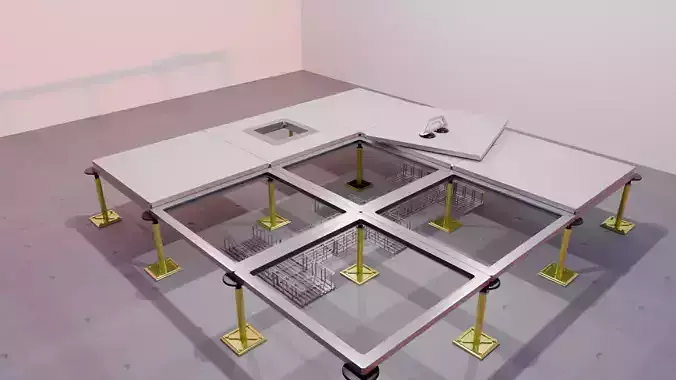1/5
A raised floor (also raised flooring, access floor(ing), or raised-access computer floor) provides an elevated structural floor above a solid substrate (often a concrete slab) to create a hidden void for the passage of mechanical and electrical services. Raised floors are widely used in modern office buildings, and in specialized areas such as command centers, Information technology data centers and computer rooms, where there is a requirement to route mechanical services and cables, wiring, and electrical supply. Such flooring can be installed at varying heights from 2 inches (51 mm) to heights above 4 feet (1.2 m) to suit services that may be accommodated beneath. Additional structural support and lighting are often provided when a floor is raised enough for a person to crawl or even walk beneath.
In the U.S., underfloor air distribution is becoming a more common way to cool a building by using the void below the raised floor as a plenum chamber to distribute conditioned air, which has been done in Europe since the 1970s. In data centers, isolated air-conditioning zones are often associated with raised floors. Perforated tiles are traditionally placed beneath computer systems to direct conditioned air directly to them. In turn, the computing equipment is often designed to draw cooling air from below and exhaust into the room. An air conditioning unit then draws air from the room, cools it, and forces it beneath the raised floor, completing the cycle.
Above describes what has historically been perceived as raised floor and still serves the purpose for which it was originally designed. Decades later, an alternative approach to raised floor evolved to manage underfloor cable distribution for a wider range of applications where underfloor air distribution is not utilized. In 2009 a separate category of raised floor was established by Construction Specifications Institute (CSI) and Construction Specifications Canada (CSC) to separate the similar, but very different, approaches to raised flooring. In this case the term raised floor includes low-profile fixed-height access flooring.[3] Offices, classrooms, conference rooms, retail spaces, museums, studios, and more, have the primary need to quickly and easily accommodate changes of technology and floor plan configurations. Underfloor air distribution is not included in this approach since a plenum chamber is not created. The low-profile fixed-height distinction reflects the system's height ranges from as low as 1.6 to 2.75 inches (41 to 70 mm); and the floor panels are manufactured with integral support (not traditional pedestals and panels). Cabling channels are directly accessible under light-weight cover plates.
REVIEWS & COMMENTS
accuracy, and usability.





